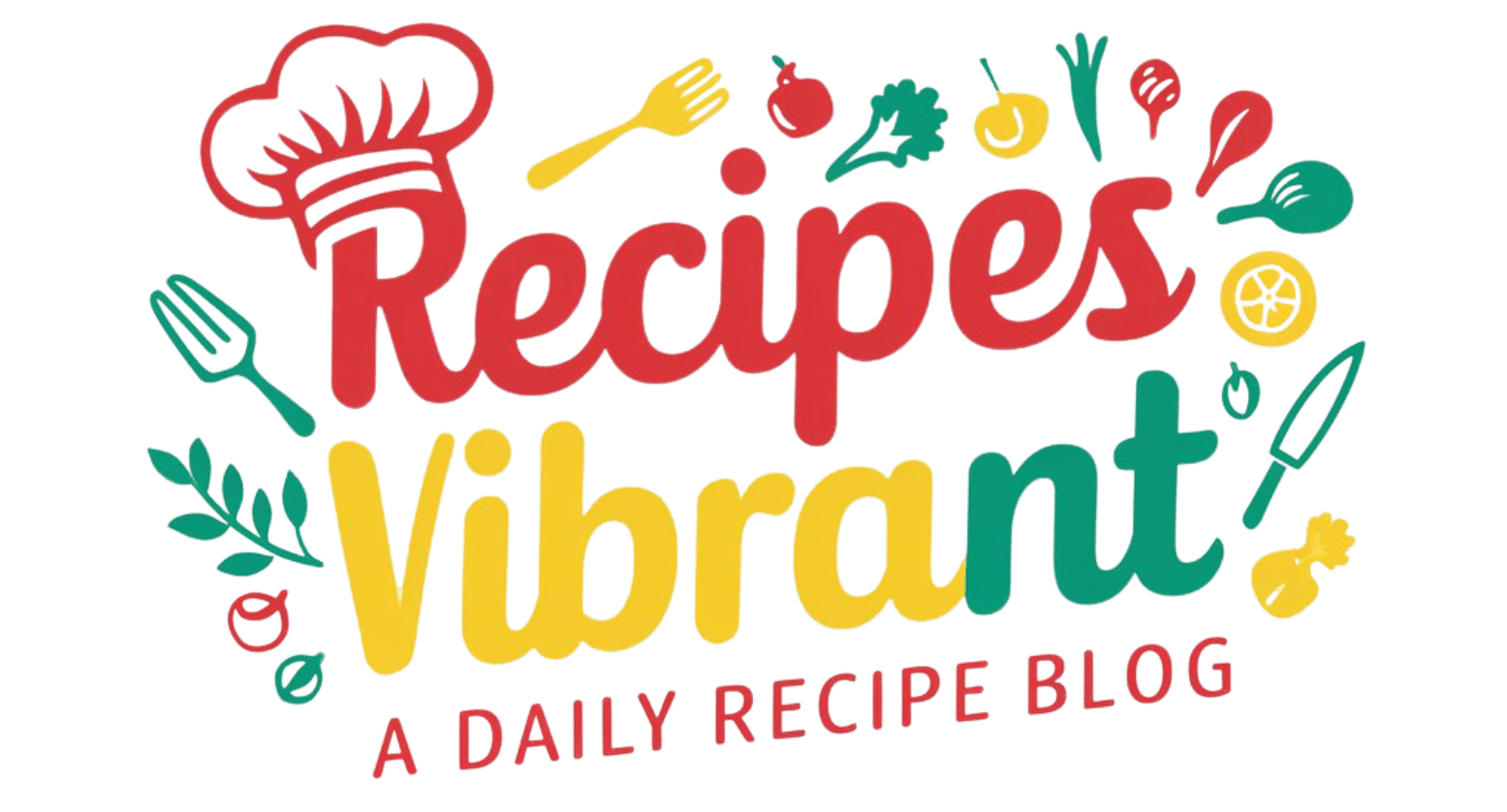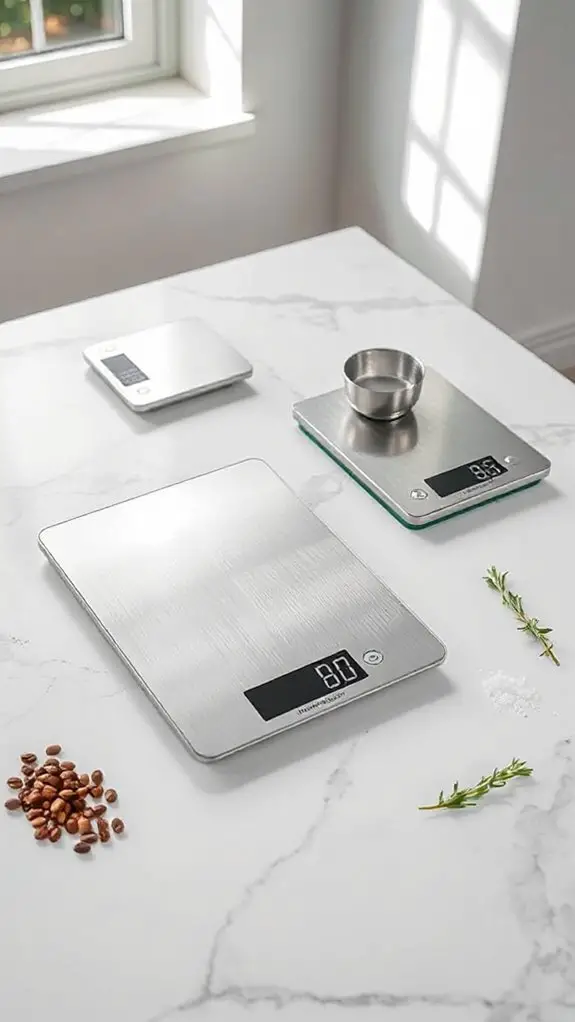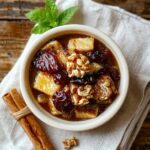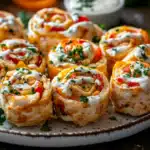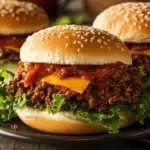I’ve been testing kitchen scales to find the best tools for precision cooking in 2025, and three models stand out for their accuracy and ease of use. Whether you’re baking or meal prepping, a good scale can make all the difference—but which one fits your needs? Let’s break down the top picks, from sleek stainless steel designs to budget-friendly options, so you can decide which deserves a spot on your counter.
OXO Good Grips 11-Pound Stainless Steel Food Scale with Pull-Out Display
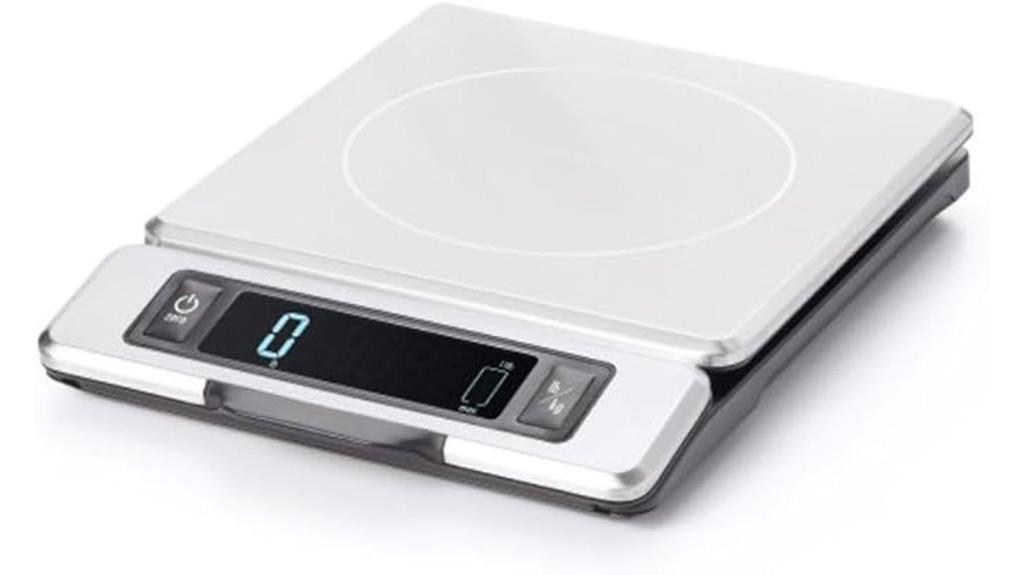
Precision cooking enthusiasts, whether they’re mastering a delicate soufflé or measuring ingredients for a family meal, will find the OXO Good Grips 11-Pound Stainless Steel Food Scale with Pull-Out Display a game-changer. Its smudge-resistant stainless steel surface and pull-out display guarantee readability, even with bulky bowls blocking the screen. The scale measures up to 11 pounds with 1/8-ounce accuracy, making it perfect for everything from baking to portioning. A zero/tare function allows for precise ingredient additions, while unit conversion switches effortlessly between ounces, grams, and more. Compact and easy to clean, it’s a reliable tool that fits seamlessly into any kitchen routine.
Best For: Precision cooking enthusiasts and home bakers who need accurate measurements and a user-friendly scale.
Pros:
- Smudge-resistant stainless steel surface ensures durability and easy cleaning.
- Pull-out display prevents shadowing from large bowls or pots.
- Accurate measurements with 1/8-ounce increments and unit conversion options.
Cons:
- Auto shutoff feature may interrupt longer cooking sessions.
- Requires 4 AAA batteries, which may need frequent replacement with heavy use.
- Compact size may not accommodate very large or oddly shaped containers.
Etekcity Digital Food Kitchen Scale in Stainless Steel
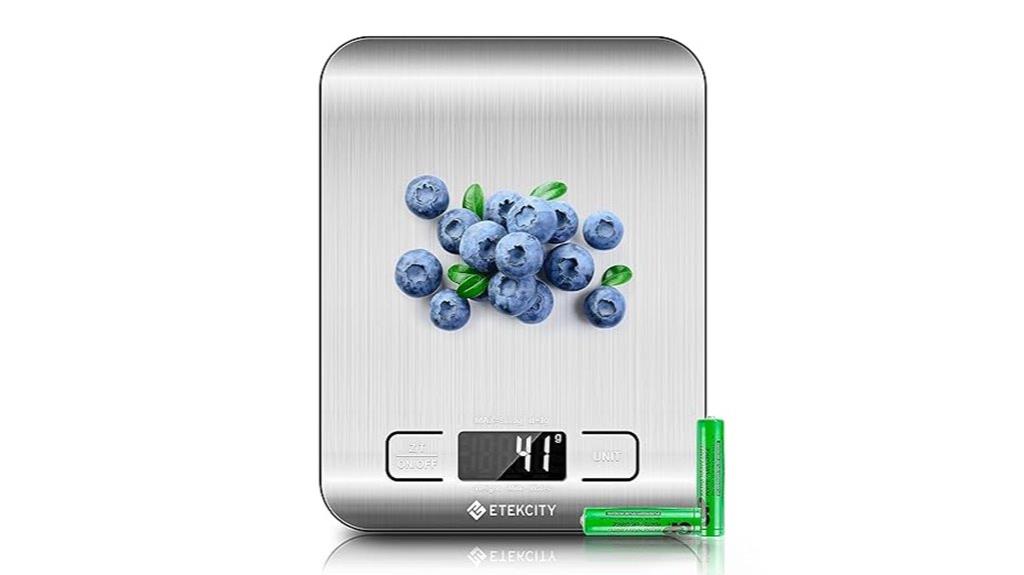
For anyone who loves baking, counts calories, or just wants to nail that perfect recipe, the Etekcity Digital Food Kitchen Scale in Stainless Steel is a game-changer. This compact scale, with its sleek 304 food-grade stainless steel surface, is easy to clean and fits neatly on any countertop. It weighs up to 11 pounds with precise 1-gram increments, making it perfect for baking, meal prep, or portion control. The tare function lets you subtract container weights, while the backlit LCD display guarantees easy reading. Portable and battery-powered, it’s a reliable tool for both home cooks and pros alike. Simple yet versatile, it’s a kitchen must-have!
Best For: Home cooks, bakers, and health-conscious individuals who need precise measurements for recipes, portion control, or meal prep.
Pros:
- Accurate weighing up to 11 lb with 1 g increments for precise measurements.
- Tare function and easy unit switching (g/oz/lb:oz/mL/floz) enhance usability.
- Compact, portable, and durable with a food-grade stainless steel surface.
Cons:
- Buttons can occasionally be unresponsive.
- Display visibility may vary in certain lighting conditions.
- Minimum measurement of 2 g may not suit ultra-precise needs.
Amazon Basics Digital Kitchen Scale with LCD Display
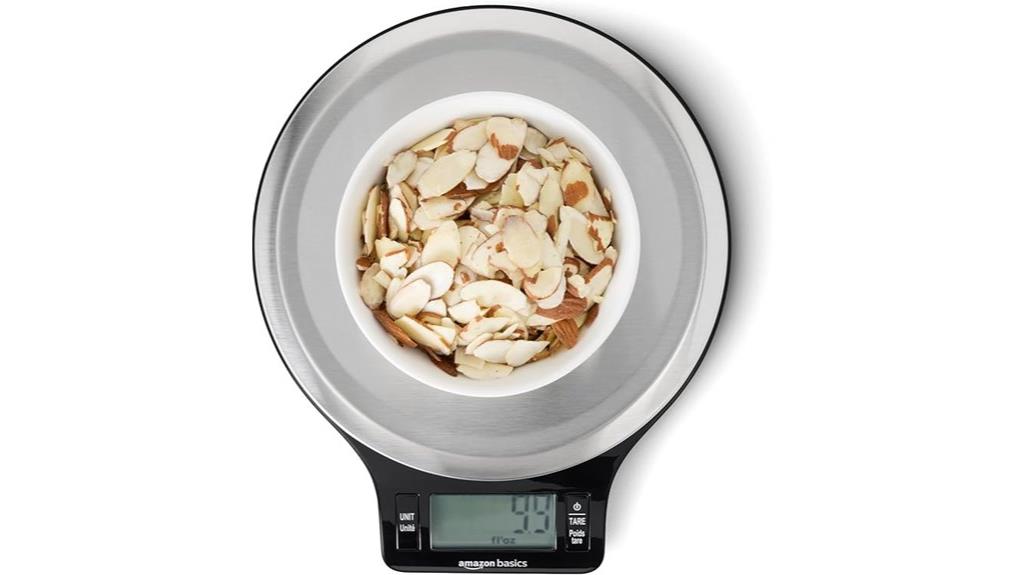
Whether you’re a beginner baker or a seasoned chef, the Amazon Basics Digital Kitchen Scale with LCD Display is a must-have tool for anyone serious about precision cooking. It features a bright, easy-to-read screen and a stainless steel platform that’s both durable and easy to clean. The scale weighs up to 11 pounds and switches seamlessly between grams, ounces, and milliliters, making it perfect for recipes of all kinds. With its handy tare function, you can measure ingredients directly in bowls or plates. Compact and lightweight, it’s a reliable, affordable option for baking, meal prep, and nutrition tracking.
Factors to Consider When Choosing a Kitchen Scale
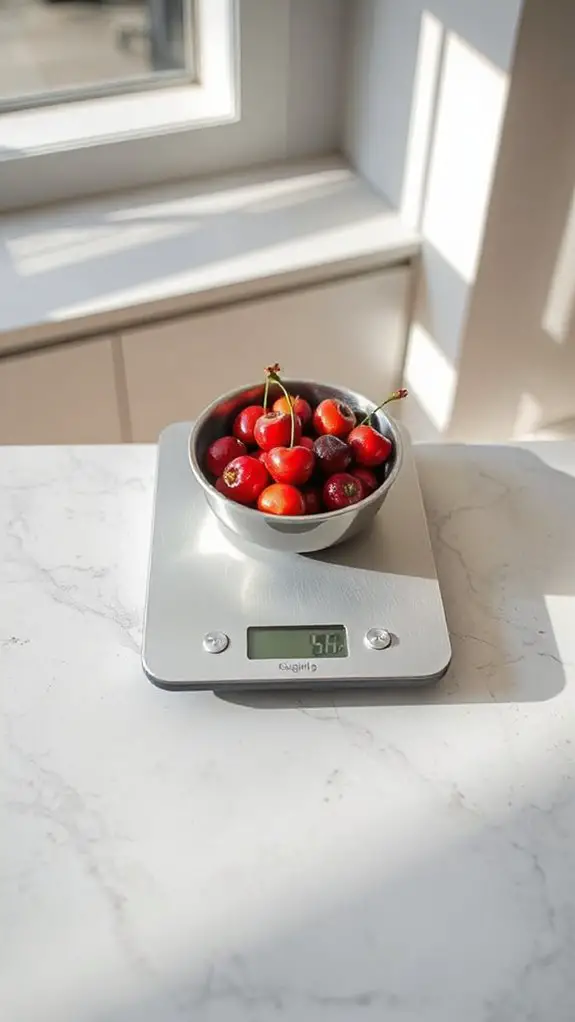
When I’m choosing a kitchen scale, I always check for accuracy because even tiny measurements can make a big difference in recipes. I also look for a scale with clear display readability and easy unit conversion, so I’m not stuck guessing how many grams are in an ounce. Finally, I make sure it’s simple to clean, because nobody wants to deal with sticky crumbs stuck in hard-to-reach places.
Accuracy and Precision
Since I’ve started paying closer attention to measurements, I’ve realized how much accuracy and precision can make or break a recipe. If my scale isn’t reliable, even my best efforts can turn into kitchen disasters. Increments as small as 1 gram or 0.05 ounces matter, especially when baking or working with ingredients like yeast or spices. I always look for scales with a tare function—it lets me zero out the weight of my bowl, so I’m only measuring what’s inside. Consistency is also key. If my scale gives different readings for the same ingredient, I can’t trust it. Another thing I check is whether it stays precise at higher weights—no one wants surprises when scaling up a recipe. Finally, I avoid scales that reset mid-use; it’s frustrating to lose track of measurements.
Weight Capacity
Choosing the right weight capacity for my kitchen scale has been a game-changer in my cooking and baking adventures. I quickly learned that scales come with different weight limits, usually between 5 and 22 pounds. For most of my recipes, an 11-pound capacity works just fine, whether I’m measuring flour for cookies or weighing veggies for a stir-fry. But when I started making bigger batches of soup or using heavier mixing bowls, I realized a higher capacity was essential. Pushing a scale past its limit can throw off measurements or even break it, so I always make sure to pick one that fits my needs. Thinking about future recipes—like holiday baking or meal prepping—helps me choose a scale I won’t outgrow. It’s all about finding that perfect balance!
Display Readability
Because I’ve spent plenty of time squinting at tiny numbers on a kitchen scale, I can’t stress enough how important display readability is. A larger LCD screen with backlighting makes a world of difference, especially when my kitchen lighting isn’t perfect. High-contrast fonts are a must—they’re clear and easy to read, whether I’m measuring ingredients early in the morning or late at night. I also love scales with pull-out or elevated displays because they guarantee I can see the numbers even when using a big mixing bowl. Auto-shutoff features are handy for saving battery, but I appreciate when the scale remembers the tare weight so I don’t have to start over. A readable display keeps cooking smooth and frustration-free, which is always a win!
Unit Conversion
When I’m experimenting with a recipe from another country, unit conversion on my kitchen scale becomes my best friend. It’s amazing how easily I can switch between grams, ounces, pounds, or even milliliters, depending on what the recipe calls for. I don’t have to waste time doing manual calculations, which means fewer mistakes and smoother cooking sessions. Some scales let me toggle units without resetting, so I can adjust measurements on the fly. This feature is a lifesaver when I’m trying international dishes or tracking portions for my diet. Accuracy matters, and having a scale that handles conversions seamlessly guarantees my recipes turn out just right every time. It’s like having a tiny translator in my kitchen, making sure I never miss a beat.
Ease of Cleaning
Though I love experimenting in the kitchen, cleaning up afterward isn’t my favorite part, so I make sure my kitchen scale is easy to maintain. Removable platforms are a game-changer because I can wash them separately, stopping crumbs or spills from sticking around. I also look for scales with smooth, non-porous surfaces like stainless steel—they resist stains and wipe clean in seconds. Water-resistant designs are a big plus since I can use a damp cloth without worrying about damaging the electronics. Scales with fewer crevices or seams are simpler to clean because food particles don’t get trapped easily. Lightweight models are easier to handle and clean thoroughly compared to heavier ones. A clean scale keeps cooking fun and hassle-free, so these features are non-negotiable for me.
Battery Life
After making sure my kitchen scale is easy to clean, I also pay close attention to its battery life—it’s no fun running out of power mid-recipe! Most scales use AAA batteries, and I’ve found that with daily use, they typically last over a month. I appreciate models with auto-shutoff features, usually between 2 to 6 minutes, as they save battery when I forget to turn them off. Backlit displays are great for visibility, but they do drain power faster, so I weigh the trade-off. I’ve noticed frequent use of the tare function can slightly affect battery life, but it’s minimal. Some scales even retain tare weights without consuming much standby power. For me, a reliable battery life means fewer interruptions and smoother cooking sessions—something I definitely value in a kitchen scale!
Frequently Asked Questions
How Do I Calibrate My Kitchen Scale?
I’ll calibrate my kitchen scale by placing it on a flat surface and pressing the tare button to zero it out. Then I’ll add a known weight, like a calibration weight, and adjust until it matches.
Can Kitchen Scales Measure Liquids Accurately?
I’ve found kitchen scales can measure liquids accurately if I use a container, tare it first, and pour the liquid in grams or milliliters. It’s just as precise as measuring solids when done correctly.
What Is the Difference Between Mechanical and Digital Scales?
Mechanical scales measure manually, using springs and dials, while digital scales display precise numbers electronically. I find digital scales clearer and quicker, but mechanical ones don’t need batteries and are simpler to use.
Are Kitchen Scales Waterproof or Water-Resistant?
I’ve found most kitchen scales aren’t fully waterproof but are water-resistant to handle spills or splashes. I always check the product’s IP rating to confirm its resistance level since submersion could damage the scale.
How Long Do Kitchen Scale Batteries Typically Last?
How long do batteries in kitchen scales last? It’s not a simple answer, but I’ve seen some scales run for months, even years, on a single set—depending on usage. Replaceable ones often outlast built-in rechargeables.
Conclusion
When I started baking sourdough bread, I quickly realized how essential a precise kitchen scale is. My loaves transformed from dense bricks to fluffy masterpieces once I switched to the OXO Good Grips Scale. Its 1-gram accuracy made all the difference in measuring flour and water perfectly. Choosing the right scale isn’t just about precision—it’s about boosting confidence in the kitchen. Trust me, it’s worth the investment for tastier results!
